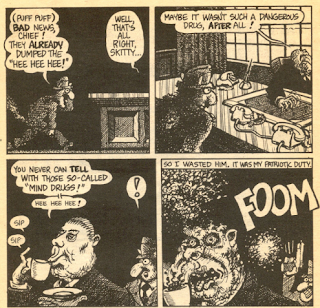Persepolis: A Visual Biography
I have read Persepolis before, for a separate literature class at Ringling and it was just as impactful then as it was now when I brushed up on it. I've never completely appreciated the illustrations, but over time I've come to understand they are less important than illustrations usually are in comics. They serve only to be an addition to the tale, instead of the vessel in which the story is contained.
The effect this gives is one where the viewer understands the circumstance, and uses it as the basis for their imagination to bring it into reality. It's all a focus on iconic images, instead of overly descriptive details. As with writing, brevity can be of upmost importance, and this is. The girls in their veils all looking similar but with the only difference being their bangs or expression gives this impactful effect of showing how the main character views the veil on an aesthetic level.
But beyond this, it's a deeply personal work that took a lot of courage to even share, let alone mass produce and sell. In the vein of I Saw It by Keiji Nakazawa, putting down personal and often traumatic instances is no small feat but contributes to the overall understanding of those who are otherwise distant from the event. In this case, I'd never even heard of these events in my euro/america-centric history classes, and as such, this was more than a story to read about an event I was aware of, but an entire awakening to an uprising I'd never known of.
This proves that comics are beyond entertainment, but truly an accesable way to access history you weren't aware of.
The effect this gives is one where the viewer understands the circumstance, and uses it as the basis for their imagination to bring it into reality. It's all a focus on iconic images, instead of overly descriptive details. As with writing, brevity can be of upmost importance, and this is. The girls in their veils all looking similar but with the only difference being their bangs or expression gives this impactful effect of showing how the main character views the veil on an aesthetic level.
But beyond this, it's a deeply personal work that took a lot of courage to even share, let alone mass produce and sell. In the vein of I Saw It by Keiji Nakazawa, putting down personal and often traumatic instances is no small feat but contributes to the overall understanding of those who are otherwise distant from the event. In this case, I'd never even heard of these events in my euro/america-centric history classes, and as such, this was more than a story to read about an event I was aware of, but an entire awakening to an uprising I'd never known of.
This proves that comics are beyond entertainment, but truly an accesable way to access history you weren't aware of.



Comments
Post a Comment